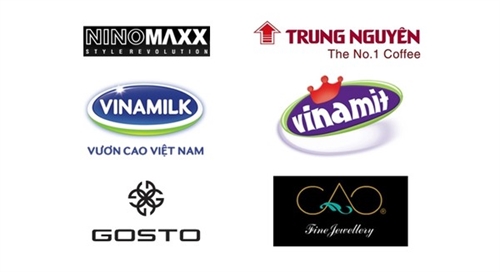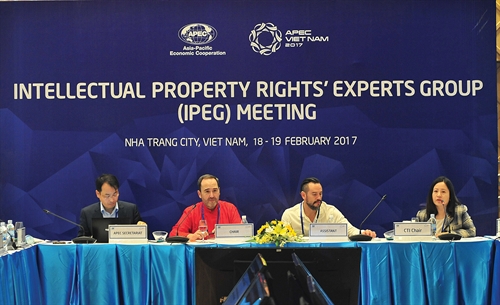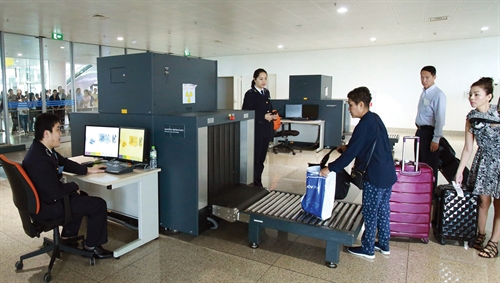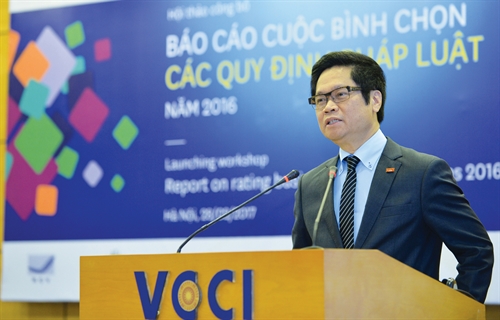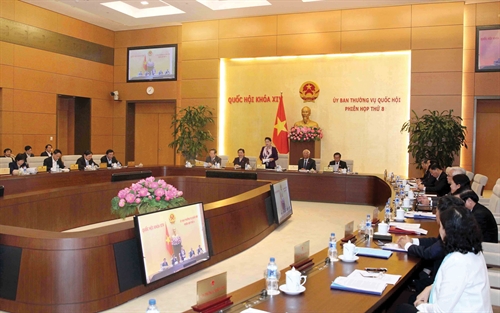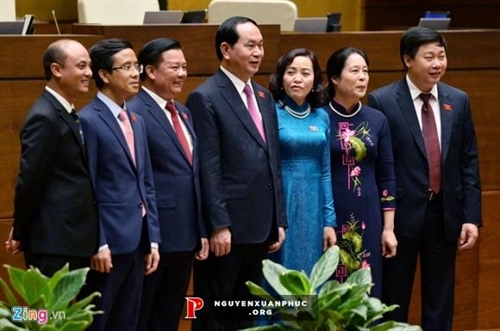Findings from the 2016 PAPI Report, released on April 4, 2017, show positive trends in public service delivery, particularly in the number of citizens receiving public health insurance and in the reported quality of primary schools. However, citizens are more concerned about the environment than in past years, and weaknesses remain in citizen engagement in decision-making, government accountability, and control of corruption in the public sector.
Dang Ngoc Dinh, Edmund J. Malesky,
Dang Hoang Giang, Paul J. Schuler and Do Thanh Huyen[1]
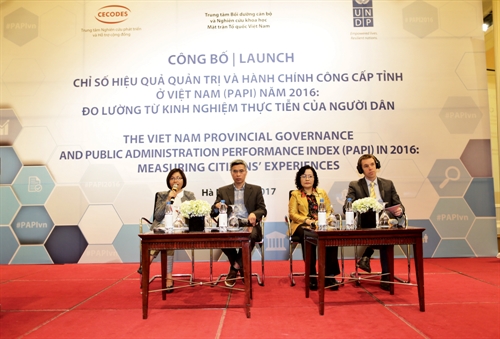 |
| Panel discussion on 2016 PAPI findings__Photo: https://papi.org.vn |
Introduction
This article presents a snapshot of key findings from the 2016 Vietnam Provincial Governance and Public Administration Performance Index (PAPI) research project.[2] The index is based on the sixth consecutive annual nationwide survey, which in 2016 captured the views and experiences of 14,063 randomly selected citizens. Since the first pilot survey in 2009, 88,962 citizens across Vietnam have engaged in face-to-face interviews and shared their experiences and assessments of governance and public administration performance by the state apparatus from the central to commune levels.
The 2016 PAPI Report has three broad aims. First, it provides a set of baseline indicators for the Government of Vietnam that can be used to track its performance during the 2016-21 term. Second, the findings can help gauge the effectiveness of ongoing institutional and policy reforms to achieve the new government’s goal “to build a government that facilitates development, acts with integrity and proactiveness, and works for its People.” Third, it identifies areas for action as the government attempts to achieve the national agenda for sustainable development.
Reflecting changing social and governance circumstances, the 2016 survey underwent several major changes. New questions were added to examine how citizens were engaging with their candidates and elected officials. Additionally, the survey asked questions pertaining to several “hot” topics such as environmental issues, concerns about inequality, views on the Trans-Pacific Partnership, and knowledge of the Law on Access to Information. Other dimensions (i.e., citizen participation at local levels, vertical accountability, and public administrative procedures) were also revised and streamlined.
Below are highlights of the national trends and main findings from the 2016 PAPI Report, as well as implications for national and provincial performance in the areas of governance and public administration.
 |
 |
National trends in governance and public administration in 2016
PAPI provides valuable insights at two levels. First, it provides an index of provincial government quality. Second, the indicators can highlight trends in national public opinion on governance and other issues over time.
Regarding views of national-level governance, three positive trends are worthy of note. First, public service delivery improved once again in 2016, meaning that it has improved each year that the PAPI survey has been conducted since 2011. Within the public service delivery dimension, 2016 was particularly notable for the large increase in the number of citizens receiving public health insurance; the proportion rose from 62 percent in 2015 to 74 percent in 2016. This reflects a broader improvement in health care indicators highlighted in the 2016 PAPI report.
Another notable improvement was in citizen participation in elections. The voter turnout for National Assembly elections was 69 percent, a 2 percent increase from the percentage reported in the 2011 survey results. This rise is a potential indicator of the rising prominence of the National Assembly, and the increasing attention of citizens to its policy influence.
Finally, for the third successive year since the revised 2013 Land Law was passed, respondents reported substantially fewer land seizures than prior to the revision. Before 2013, an average of 9 percent of citizens reported having land seized compared to an average of 6.5 percent after 2013. This suggests that the amendment did in fact impose greater constraints for local officials in terms of acquiring land from citizens. The 2016 PAPI report also assesses differences in land title registration between men and women, showing that 13 percent fewer women have their names on land use rights certificates than men. This gap may pose a barrier to female entrepreneurship, as access to lending to start a business often depends on using land use rights certificates (LURCs) as collateral.
The survey also asked questions on economic satisfaction. In 2016, respondents continued to say that their household economic situations were good and had improved over past years. Furthermore, they continued to express optimism about the future. In particular, those with higher income levels were more likely to express satisfaction with their current household economic condition and had more optimism for the future.
In addition, citizens were asked to describe their issues of greatest concern in 2016 (see Figure 1). The responses show a significant change from 2015. While poverty remained the most important issue, 2016 witnessed a 10 percent increase compared to 2015 in the percentage of respondents saying environmental problems represented the issue of greatest concern. The most obvious explanation for this sudden, major shift was the widespread reporting of the fish kill in the central coast in April 2016.
Nonetheless, concerns about the environment were not localized to the central coast region that was most directly impacted by the fish kill crisis, but have spread further. For example, the survey also reveals concerns about increasing air and water pollution. Salination in the Mekong Delta and deteriorating air quality in areas around industrial premises and Hanoi were also big issues.[3] The 2016 PAPI survey results show that, more than 67 percent of surveyed citizens reported that water quality has deteriorated in the past three years, and 36 percent reported a decline in air quality. This suggests that the government should take a much closer look at environmental protection standards, and make transparent how these policies are implemented in practice so the public can scrutinize them.
The 2016 PAPI report also looks at citizen concerns with poverty, in particular how citizens view poverty reduction in comparison to other priorities such as the environment, trade, and economic growth. It shows that poverty was the highest priority for poorer respondents in 2016. Regarding poverty assistance, the findings show that poorer citizens are indeed more concerned about poverty reduction than wealthier citizens. This concern reflects a reality not often discussed in developmental discussions of poverty alleviation. Escaping from poverty is a fragile phenomenon. A simple health crisis and subsequent hospital charges can knock a family below the poverty line. However, even among the wealthiest respondents, poverty is the top priority.
Finally, reflecting the salience of the proposed Trans-Pacific Partnership (TPP), of which Vietnam would be a member if ratified, the survey included a series of questions about citizen awareness and support for the pact. While U.S. withdrawal from the agreement likely means TPP will not happen in its current form, the survey results are exemplary of larger popular understanding of globalization among the Vietnamese population. The results reveal strikingly low levels of citizen awareness of the pact, with only 27 percent expressing awareness. While support was high for the initiative, it was thin in the sense that respondents had little information about its provisions. Those who did have information were more likely to support the measure. The informed citizens also tended to be members of mass organizations, suggesting the importance of information dissemination.
Provincial performance in 2016
Moving to the second level of analysis, despite changes made to three out of the six PAPI dimensions, provincial patterns in 2016 were consistent with the 2011-15 trends. Better performing provinces were mostly clustered in the northeastern, central coast, and Mekong delta regions, similar to previous surveys. Among the 16 best performers are the northeastern provinces of Hai Duong, Bac Ninh, Bac Giang, Nam Dinh, Thai Binh, Hung Yen, and Ninh Binh; five central coast provinces (Ha Tinh, Da Nang, Quang Binh, Quang Tri, and Binh Dinh); and three Mekong delta provinces (Can Tho, Ben Tre, and Dong Thap). It is worthwhile noting that Nam Dinh, Ha Tinh, Quang Tri, and Da Nang have maintained their overall best performance status for six years in a row.
At the other end of the 2016 performance spectrum are northernmost and southernmost provinces. In particular, Yen Bai, Lang Son, Cao Bang, Ha Giang, and Lai Chau are in the same poorest performing group as Ca Mau, Bac Lieu, Tra Vinh, and Kien Giang. Lai Chau has been in the poorest performing group since 2011. While these provinces are rated as needing improvement, to a certain extent they may be penalized because of their disadvantaged socio-economic circumstances. Under Vietnam’s public finance system, less economic activity results in reduced revenue that can be spent on public services and infrastructure. However, not all poor-performing provinces are in disadvantaged areas. For example, Hanoi joined this group in 2016 together with Khanh Hoa, Quang Ninh, and Binh Duong, where conditions for socio-economic development are more favorable. Binh Duong, in particular, saw a severe decline for the second year in a row.
Below are highlights of provincial performance in 2016 on each of the six dimensions:
- Citizen participation at local levels. Consistent with previous years, there were strong regional patterns. Among the 16 best performing provinces in 2016, 13 were in the Red River delta and northern central sub-regions. Meanwhile, 11 out of the poorest performing provinces were found in the southeastern and Mekong delta sub-regions. The best five performing provinces were Ha Tinh, Bac Ninh, Bac Giang, Thai Binh, and Thai Nguyen, with their average scores ranging from 6.2 to 6.8 points on the dimension’s 1-10-point scale. The five poorest performing provinces were Tra Vinh, Binh Duong, An Giang, Kien Giang, and Ca Mau.
- Transparency in local decision-making. Of the 16 best performers in this dimension, 14 were northern and central provinces. The poorest performers were found more often in the south, with the four poorest performing provinces of Soc Trang, Tra Vinh, Ca Mau, and Bac Lieu having mean dimensional scores of around 4.8 points, below the average level. By the three sub-dimensions, Da Nang was the best performer in 2016 on land transparency, Bac Ninh on transparency of poverty lists, and Binh Phuoc on access to commune budgets and expenditure lists. Compared to 2011, 13 provinces saw improvements of more than 5 percent in 2016. The largest hike was seen in Phu Tho (+29 percent) while the steepest drop was again seen in Ba Ria-Vung Tau (-19.5 percent).
- Vertical accountability toward citizens. While this dimension saw some of the most dramatic changes, regional patterns were similar to those found in previous years, despite a change in the composition of the dimension in 2016. There is a convergence of best performers in the northern and central regions in this dimension. Among the 16 best performers in 2016, six are northern provinces and four are central ones. Quang Ngai, a central coast province, was the top performer. On the other hand, the six poorest performers are from the Mekong Delta, with Kien Giang being the poorest performer among all 63 provinces.
- Control of corruption in the public sector. The decline in overall provincial performance in this dimension continued in 2016. The largest declines were seen in two sub-dimensions: “limits on public sector corruption” and “willingness to fight corruption.” Regional patterns follow previous years. Central and southern provinces tend to do better in anti-corruption efforts than northern provinces. Among the top 16 best performers, eight are Mekong delta provinces and five are from the central coast region. In 2016, Can Tho, Tien Giang, and Ben Tre were the best performers in this dimension. Long An remained in the best performing group for the sixth year in a row, while Hanoi has been in the poorest performing group over the same period. Two other centrally governed municipalities, Ho Chi Minh City and Hai Phong, joined this poor performing group, along with five northern and three Central Highlands provinces. A total of 27 provinces significantly improved their performance in 2016 against their score in 2011. Cao Bang’s dimensional score increased 36 percent over six years, while Binh Duong saw the sharpest drop of 40 percent compared to 2011.
- Public administrative procedures. All provinces maintained their level of performance from previous years in provision of certification services, construction permits, LURCs, and personal procedures for their citizens. Similar to previous years’ findings, there is no clear geographic pattern. Best performers can be found across the country, but among the poorest performing provinces are four Central Highlands provinces: Gia Lai, Lam Dong, Kon Tum and Dak Nong. Of the four public administrative services, the public administrative procedures and services for LURCs rated the poorest generally, similar to previous years.
- Public service delivery. In this dimension, there was a wider gap between provinces in 2016 than in the previous five years. The difference between the best performing province (Da Nang, with a dimensional score of 8.03 points) and the lowest scoring one (Quang Ngai, with a score of 6.42) is larger than in previous years. Indeed, the survey results reveal a change in the landscape of provincial performance related to public service delivery. In the previous five years, the best performers were concentrated more in the south than in other regions of the country. Da Nang, Ho Chi Minh City and Ba Ria-Vung Tau have consistently been in the best performing group since 2011. Hanoi is the only centrally governed municipality that falls far below this group. For 2016, a more even regional distribution of provinces in the best performing group is seen. As observed in the PAPI 2015 Report, none of the provinces have fallen behind dramatically since 2011. A total of 35 provinces saw noticeable improvement in 2016 compared to 2011, while the rest saw insignificant changes. Dak Nong made the most impressive improvement in 2016 compared to its 2011 benchmark.
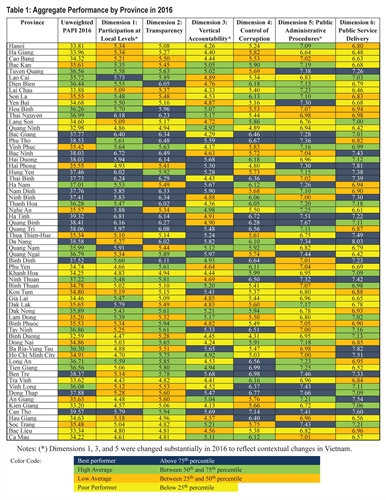
Implications of the 2016 PAPI findings
Given the wealth of information in the PAPI Report and the underlying survey results, central and local governments can use the findings to assess where they have done well and where they should target their efforts in the upcoming years in the areas of governance and public administration.
The aggregate national trends show areas where citizens desire the most action. In particular, improvements are needed in the areas of citizen engagement in decision-making, transparency in local planning, government accountability toward citizens, and control of corruption in the public sector. The results also show that the environment is an important issue for citizens across the country, while poverty remains an ever-present concern. On the positive side, the report also shows areas where citizens see improvement, such as in the health care sector and public administrative procedures at the commune level.
The detailed findings presented by province reflect provincial strengths and weaknesses, offering leaders multi-faceted insights about how provinces perform and how they compare in different aspects of governance and public administration. For instance, most provinces have improved their performance in public service delivery, as evident in the fact that the vast majority of provinces scored higher in the dimension ‘Public Service Delivery’ in 2016 than in 2011. However, most provinces need to do more to improve the competence and attitude of civil servants and public employees, and enhance the transparency, responsiveness and accountability of their institutions (see Table 1).
Indeed, the 2016 PAPI results show that shortcomings and weaknesses in provincial performance in governance and public administration are evident in the whole state apparatus and in the level of citizen engagement. On the one hand, they are embedded in the social context in which public officials and civil servants are not encouraged to be responsive, accountable and understanding of citizen rights and concerns. On the other hand, citizens are not motivated to provide feedback and comments in a constructive manner to help local governments perform better. The causes of these shortcomings are primarily structural: a lack of citizen consultation during the processes of developing and implementing policies and procedures, and the fact that policies and procedures are not adequately publicized, made transparent, complied with, or enforced.
To address these challenges, the central government and local governments may wish to adopt a holistic approach, with clear priorities, milestones, outputs, and outcomes assigned to each of the identified challenges. The following three-pronged approach can be used within the current institutional settings:
(i) Citizens should be more active in policy making, policy implementation, and policy monitoring, because engaged citizens inform the government of their needs and expectations and are enabled in this way to assume greater ownership of, and responsibility for, public policies and solutions.
(ii) The behavior and skills of public officials and civil servants can be enhanced by using evidence-based approaches to training and apprenticing. This will help these individuals to gain new skills, allowing them to become enablers, negotiators and collaborators with their citizen clients. This approach requires concrete job descriptions and performance appraisals for each public sector staff, so that they proactively engage with citizens in each stage of policy development and implementation.
(iii) It is important to create and promote a culture of openness and transparency from the government side. This requires a robust legislative regime that enables freedom of information, transparency in decision-making, responsiveness toward citizens, and accountable institutions.
Finally, with its rights-based and citizen-centric approaches to policy implementation monitoring, PAPI will also be a useful tool to measure Vietnam’s progress in implementation of the Sustainable Development Goals (SDGs) of the 2030 Agenda for Sustainable Development. The 2030 Agenda is about leaving no one behind, and PAPI reflects the experience of all segments of the population thanks to its representative sampling and nationwide coverage. In particular, Goal 16 is about building effective, accountable, and inclusive institutions at all levels, and PAPI aims to help call local governments into account and to inform policies and action plans to improve the performance of public institutions in reducing corruption and becoming accountable and transparent. The analysis of the linkages between PAPI and the SDGs in the 2016 PAPI Report shows how valuable PAPI data is for gauging Vietnam’s implementation of Goal 16.-
